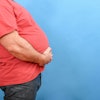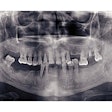The human body is better at fighting periodontal disease when fat cells -- which trigger inflammation -- disappear, according to a study in the Journal of Periodontology (October 20, 2011).
Researchers from Case Western Reserve University School of Dental Medicine conducted a pilot study involving 31 obese people with periodontal disease. Half of the group with an average body mass index (BMI) of 39 underwent gastric bypass surgery and had fat cells from the abdomen removed. That half fared better than a control group of obese people with a BMI of 35 who also were treated for periodontal disease but did not have the gastric bypass surgery or fat removed.
The majority of those who underwent surgery had a drop in their glucose levels after the procedure, a result that bodes well for overweight people predisposed to diabetes and insulin-related problems, the researchers noted.
All study participants underwent nonsurgical periodontal treatments of scaling/root planing and oral hygiene instructions for home care. While both groups showed improvement, the surgery group did even better on the measures for periodontal attachment, bleeding, probing depths, and plaque levels.
The researchers had two hypotheses to explain the result. They speculated that excessive fat cells secrete more cytokines (such as TNF and IL-6), which make insulin more resistant to doing its function. As a result, hyperglycemia occurs. Losing weight, therefore, makes insulin less resistant and improves the diabetic status. This in turn helps in the response to periodontal treatment.
The other theory relates to the presence of the leptin hormone that regulates appetite. Leptin plays a role in regulating metabolism and has been linked to inflammation by increasing the production of cytokines and the –C-reactive protein, which is also linked to inflammation. Leptin production was reduced after bariatric surgery and may be one explanation for the better outcomes in the periodontal treatment.
A longitudinal study to support their preliminary findings is expected.



















